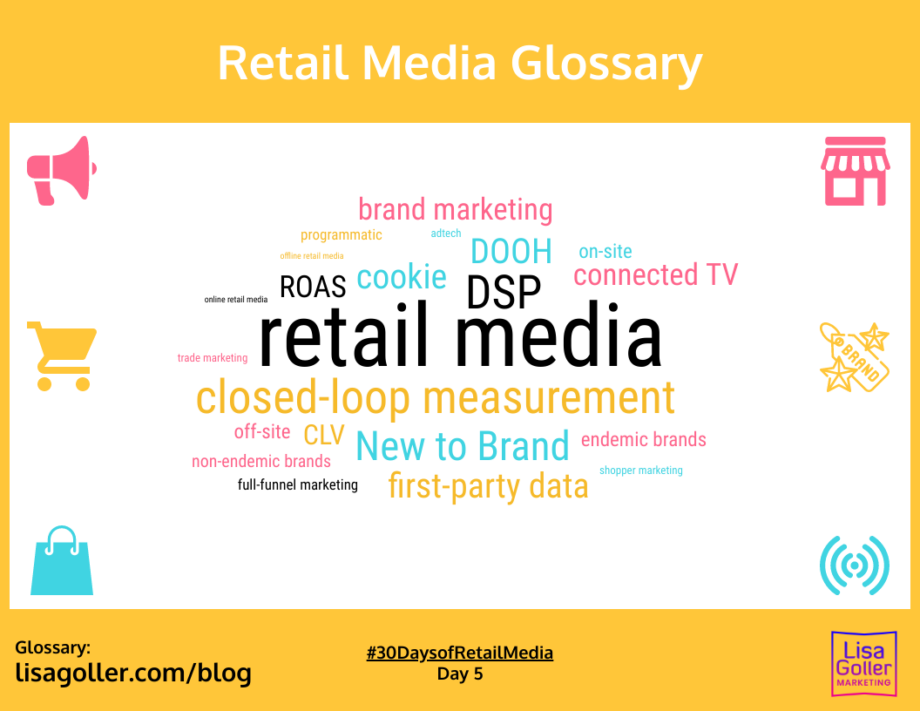#30DaysofRetailMedia | Day 5: Retail Media Glossary
Are you fluent in retail media?
I certainly wasn’t when I started studying this space last year. (So many acronyms! Holy moly.)
That’s why I compiled a glossary of common terms to help us speak the language of retail media.
See the glossary, below, which cites retail media experts like Amazon Advertising, dunnhumby and The Trade Desk.
What terms would you add?
🛍 📣 🛍 📣 🛍 📣
Glossary of retail media terms
Adtech:
A set of technologies used for managing ads across channels, including search, display, video, mobile and social, with functions for targeting, design, bid management, analytics, optimization and automation of digital advertising.
Brand marketing:
A primarily top-funnel form of marketing focused on making a potential customer aware of a brand or product, and strategically nurturing them toward a future purchase using third-party cookies, behavioral data and demographic consumer data.
Closed-loop measurement:
Closed-loop measurement links exposure data from campaigns to transaction data, whether in-store or online.
Commerce media
The evolution of marketing, which incorporates elements of performance marketing and brand marketing to meet full-funnel objectives. Commerce media uses large-scale first-party data and a wide range of formats/channels (from video and CTV to contextual and sponsored product ads) — all while enabling closed-loop measurement.
Connected TV (CTV):
CTV refers to devices that are connected to the Internet and allow viewers to stream videos and music, and browse the web.
Cookie:
A small text file stored on the user’s computer, specifically designed to gather information from a user’s device to display relevant ads.
Customer lifetime value (CLV):
CLV shows you the predicted profit, over time, that a customer will bring you.
Demand-side platform (DSP):
A DSP system allows buyers of digital advertising inventory to manage multiple ad exchange and data exchange accounts through one interface.
Digital out-of-home (DOOH):
DOOH advertising helps brands reach audiences in public environments, including digital billboards, bus signs, elevators, offices and gyms.
Endemic brands:
Brands whose ads promote a product or service that is sold by the retailer.
First-party data:
First-party data is information the retailer collects directly from its customers and owns, e.g. through a loyalty card scheme.
Full-funnel marketing:
A strategy that considers the entire shopper journey in specific stages e.g. awareness, consideration and conversion.
New To Brand:
Metric that measures how many of your conversions come from customers who haven’t bought from your brand within the past year.
Non-endemic brands:
Brands whose ads promote a product or service that isn’t sold by the retailer.
Offline retail media:
Offline touchpoints include physical stores, in-store samples, physical coupons and direct mail.
Online retail media:
Online touchpoints include websites, mobile apps, social media and digital circulars.
Off-site retail media:
Paid media, including external websites, apps and social media.
On-site retail media:
Retailers’ owned media, including their websites, apps and influencer marketing.
Programmatic:
Programmatic ad buying is the use of software to buy digital advertising. Programmatic advertising enables marketers to target audiences using more detailed parameters. This technology platforms provide access to dozens of third-party data vendors that provide audience segments for ad targeting at a cost.
Retail media:
A broad set of advertising tools and infrastructure, where brands leverage a retailer’s customer data, digital platforms, in-store experiences or customer analytics for advertising execution and measurement.
Return on advertising spend (ROAS):
ROAS is a marketing metric that measures the efficacy of a digital advertising campaign. ROAS helps online businesses evaluate which methods are working and how they can improve future advertising efforts.
Share of voice (SOV):
SOV is a measure of the market your brand owns compared to your competitors. It acts as a gauge for your brand visibility and how much you dominate the conversation in your industry.
Shopper marketing:
Activities focused on reaching a consumer along their online or offline shopping journey at the point of purchase.
Trade marketing:
A strategy focused on wholesalers, retailers and distributors rather than consumers, with the goal of increasing demand with supply chain partners and getting products in front of consumers.
Walled garden:
A network or service that either restricts or makes it difficult for users to obtain applications or content from external sources. For example, cable TV and satellite TV are walled gardens, offering a finite number of channels and programs to their subscribers.
Sources:
Amazon Advertising
Bigcommerce
Brandcrush
Coresight Research
Criteo
Digital Marketing Institute
dunnhumby
Gartner
IAB Canada
Inside Retail
Intentwise
Liveintent
PC Magazine
Sprout Social
The Trade Desk
Valentin Radu
Related:
Endemic vs. Non-Endemic Brands in Retail Media
On-Site vs. Off-Site Retail Media
Online vs. Offline Retail Media
Retail Media is on Fire






One thought on “Retail Media Glossary”